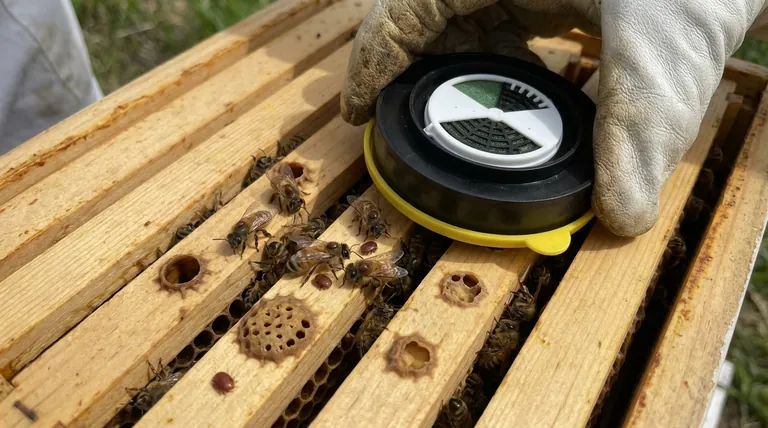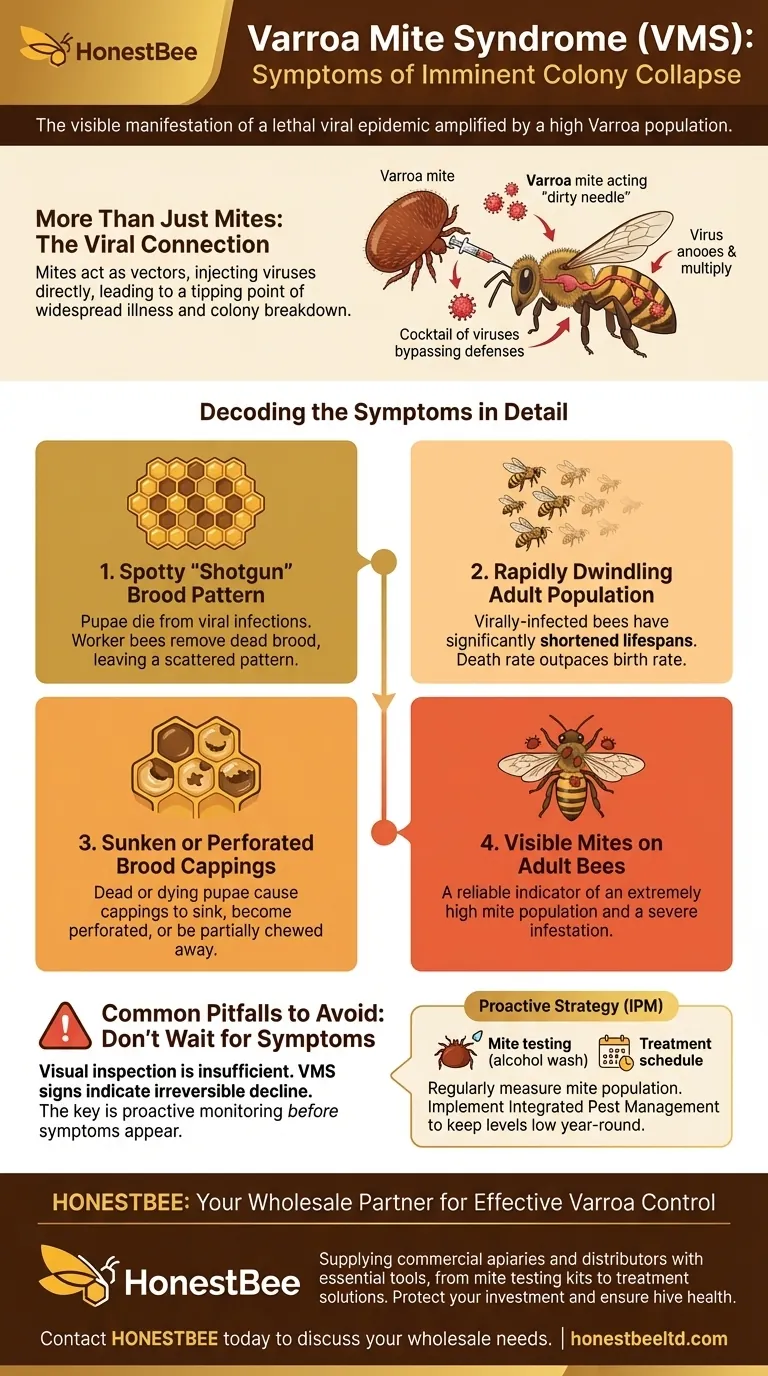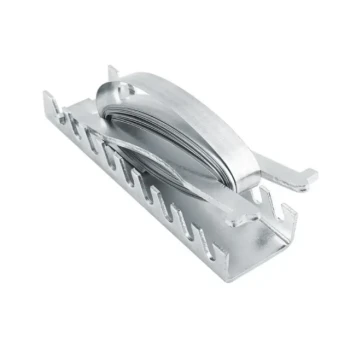The primary symptoms of Varroa Mite Syndrome (VMS) are a rapidly dwindling bee population, a spotty or "shotgun" brood pattern, and the visible presence of mites on adult bees or within brood cells. You may also observe sunken or perforated brood cappings, though typically without the foul odor associated with other brood diseases. These signs indicate a colony is in the final stages of collapse.
Varroa Mite Syndrome is not simply a mite infestation; it is the catastrophic outcome of mite-transmitted viruses, primarily Deformed Wing Virus (DWV), reaching epidemic levels. By the time you see the classic symptoms of VMS, the underlying viral load has likely overwhelmed the colony's ability to survive.

What VMS Truly Represents: More Than Just Mites
Understanding VMS requires shifting your focus from the mite itself to what the mite transmits. The syndrome is the visible manifestation of a lethal viral epidemic that has been amplified by a high Varroa population.
The Mite as a Viral Vector
Think of a Varroa mite as a dirty needle. Each time a mite feeds on an adult bee or a developing pupa, it injects a cocktail of viruses directly into the bee's open circulatory system (hemolymph). This bypasses the bee's natural defenses, allowing viruses to replicate uncontrollably.
The Tipping Point of Viral Overload
A healthy colony can tolerate a low level of viruses. However, as the mite population grows, so does the rate of virus transmission. Eventually, the viral load reaches a tipping point, causing widespread illness, shortened lifespans, and a breakdown of the colony's social immune system.
A Sign of Imminent Collapse
The symptoms of VMS are not early warning signs; they are evidence that the colony is already in a state of irreversible decline. The internal systems of the hive—brood rearing, foraging, and defense—are failing.
Decoding the Symptoms in Detail
Each symptom of VMS tells a specific part of the story of a colony's collapse.
Spotty Brood Pattern
A healthy queen lays eggs in a dense, compact pattern. A spotty, "shotgun" pattern emerges when pupae die in their cells from viral infections. Worker bees then uncap and remove the dead brood, leaving empty cells scattered among healthy, capped ones.
Dwindling Adult Population
Virally-infected adult bees have significantly shorter lifespans. Their ability to navigate and forage is impaired, and they are more susceptible to other stressors. The colony's death rate begins to rapidly outpace its birth rate, causing the population to shrink dramatically, even during a nectar flow.
Sunken or Uncapped Brood
Healthy brood cappings are slightly convex or dome-shaped. Pupae that have died or are dying underneath the capping will cause it to sink, become perforated, or be partially chewed away by house bees attempting to remove them. The lack of a strong, foul odor helps differentiate this from bacterial diseases like American Foulbrood.
Visible Mites on Adult Bees
Varroa mites prefer the relative safety of capped brood cells for reproduction. When you begin seeing mites riding on the backs of adult worker bees or drones, it is a reliable indicator that the mite population is extremely high and the infestation is severe.
Common Pitfalls to Avoid
Trusting visual inspection alone is the most common and dangerous mistake in managing Varroa mites. The key is to act long before the signs of VMS ever appear.
The Danger of Waiting for Symptoms
If you can see the symptoms of VMS with your naked eye, the colony is likely too sick to be saved. Treatment at this stage may kill the mites, but it cannot undo the damage from the viral epidemic that has already taken hold.
Confusing Mite Presence with VMS
Seeing a few mites in a hive is normal. VMS, however, is the result of an uncontrolled mite population. The goal of a beekeeper is not to eradicate every mite but to keep the population below the threshold where viral epidemics can occur.
The Need for Proactive Monitoring
The only way to effectively manage Varroa is to measure the mite population regularly using a standardized method, such as an alcohol wash or a powdered sugar roll. This gives you an accurate data point to guide your treatment decisions before the colony's health is compromised.
Making the Right Choice for Your Goal
Your strategy should be dictated by a proactive approach, not a reactive one.
- If your primary focus is early detection: You must perform regular mite counts (e.g., monthly alcohol washes) to assess the true level of infestation.
- If your primary focus is preventing VMS: Implement an Integrated Pest Management (IPM) plan to keep mite levels low year-round, using a rotation of treatments to avoid resistance.
- If you are already seeing VMS symptoms: Treat immediately to reduce the mite load, but understand the colony has a low chance of survival and poses a risk of spreading mites to other hives in your apiary.
Ultimately, successful Varroa management is defined by preventing the symptoms of VMS, not by treating them after they appear.
Summary Table:
| Symptom | What It Indicates |
|---|---|
| Spotty Brood Pattern | Pupae are dying from viral infections, leaving empty cells. |
| Rapidly Dwindling Population | Adult bees have shortened lifespans due to high viral loads. |
| Sunken/Perforated Cappings | Dead or dying pupae cause cappings to sink or be chewed open. |
| Mites Visible on Adult Bees | A sign of a severe, uncontrolled mite infestation. |
Don't Wait for Symptoms to Appear
By the time you see the signs of Varroa Mite Syndrome (VMS), your colony is likely in irreversible decline. Successful beekeeping requires proactive management with the right equipment and supplies.
HONESTBEE is your trusted wholesale partner, supplying commercial apiaries and beekeeping equipment distributors with the essential tools for effective Varroa control. From mite testing kits to treatment solutions, we provide the reliable equipment you need to implement a successful Integrated Pest Management (IPM) plan and prevent colony loss.
Protect your investment and ensure the health of your hives. Contact HONESTBEE today to discuss your wholesale needs and keep your apiary thriving.
Visual Guide

Related Products
- Adjustable Formic and Acetic Acid Dispenser for Bee Mite Treatment
- Professional Bamboo Queen Isolation Cage
- High Performance Plastic Queen Excluder for Beekeeping and Apiary Management
- Black Plastic Beetle Barn Hive Beetle Trap for Beehives
- Plastic Queen Bee Excluder for Bee Hive Wholesale
People Also Ask
- How can beekeepers ensure their hives survive the winter? A Guide to Colony Survival
- What does Chewed Down Brood (CDB) indicate in bee colonies? A Sign of Varroa Mite Infestation
- What should beekeepers do to manage varroa mites effectively? Adopt a Proactive Monitoring Strategy
- What is the optimal time for varroa mite control in nucs? Maximize Efficacy with Perfect Timing
- What should be done after treating a colony for varroa mites? A Step-by-Step Guide to Verifying Success



















